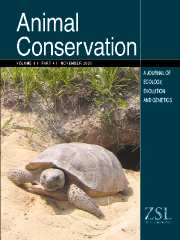Crossref Citations
This article has been cited by the following publications. This list is generated based on data provided by
Crossref.
2002.
Journal Watch.
Conservation in Practice,
Vol. 3,
Issue. 2,
p.
5.
Roemer, Gary W.
Donlan, C. Josh
and
Courchamp, Franck
2002.
Golden eagles, feral pigs, and insular carnivores: How exotic species turn native predators into prey.
Proceedings of the National Academy of Sciences,
Vol. 99,
Issue. 2,
p.
791.
Roemer, Gary W.
and
Wayne, Robert K.
2003.
Conservation in Conflict: the Tale of Two Endangered Species.
Conservation Biology,
Vol. 17,
Issue. 5,
p.
1251.
COURCHAMP, FRANCK
CHAPUIS, JEAN‐LOUIS
and
PASCAL, MICHEL
2003.
Mammal invaders on islands: impact, control and control impact.
Biological Reviews,
Vol. 78,
Issue. 3,
p.
347.
Pearson, Dean E.
and
Callaway, Ragan M.
2003.
Indirect effects of host-specific biological control agents.
Trends in Ecology & Evolution,
Vol. 18,
Issue. 9,
p.
456.
Andersen, Mark C.
Martin, Brent J.
and
Roemer, Gary W.
2004.
Use of matrix population models to estimate the efficacy of euthanasia versus trap-neuter-return for management of free-roaming cats.
Journal of the American Veterinary Medical Association,
Vol. 225,
Issue. 12,
p.
1871.
NOGALES, MANUEL
MARTÍN, AURELIO
TERSHY, BERNIE R.
DONLAN, C. JOSH
VEITCH, DICK
PUERTA, NÉSTOR
WOOD, BILL
and
ALONSO, JESÚS
2004.
A Review of Feral Cat Eradication on Islands.
Conservation Biology,
Vol. 18,
Issue. 2,
p.
310.
Dratch, Peter
Coonan, Tim
and
Graber, David
2004.
Predators and Prey in the Channel Islands.
Science,
Vol. 305,
Issue. 5685,
p.
777.
Bryant, Andrew A
and
Page, Rick E
2005.
Timing and causes of mortality in the endangered Vancouver Island marmot (Marmota vancouverensis).
Canadian Journal of Zoology,
Vol. 83,
Issue. 5,
p.
674.
Aguilar, Andres
Banks, James D
Levine, Kenneth F
and
Wayne, Robert K
2005.
Population genetics of northern pike (Esox lucius) introduced into Lake Davis, California.
Canadian Journal of Fisheries and Aquatic Sciences,
Vol. 62,
Issue. 7,
p.
1589.
Coonan, Timothy J.
Schwemm, Catherin A.
Roemer, Gary W.
Garcelon, David K.
Munson, Linda
and
Jones, Cheri A.
2005.
DECLINE OF AN ISLAND FOX SUBSPECIES TO NEAR EXTINCTION.
The Southwestern Naturalist,
Vol. 50,
Issue. 1,
p.
32.
Noonburg, Erik G.
and
Byers, James E.
2005.
MORE HARM THAN GOOD: WHEN INVADER VULNERABILITY TO PREDATORS ENHANCES IMPACT ON NATIVE SPECIES.
Ecology,
Vol. 86,
Issue. 10,
p.
2555.
BAKER, PHILIP J.
BENTLEY, AMY J.
ANSELL, RACHEL J.
and
HARRIS, STEPHEN
2005.
Impact of predation by domestic cats Felis catus in an urban area.
Mammal Review,
Vol. 35,
Issue. 3-4,
p.
302.
SARGEANT, GLEN A.
SOVADA, MARSHA A.
SLIVINSKI, CHRISTIANE C.
JOHNSON, DOUGLAS H.
and
Lubow
2005.
MARKOV CHAIN MONTE CARLO ESTIMATION OF SPECIES DISTRIBUTIONS: A CASE STUDY OF THE SWIFT FOX IN WESTERN KANSAS.
Journal of Wildlife Management,
Vol. 69,
Issue. 2,
p.
483.
GIBSON, LUKE
2006.
The Role of Lethal Control in Managing the Effects of Apparent Competition on Endangered Prey Species.
Wildlife Society Bulletin,
Vol. 34,
Issue. 4,
p.
1220.
Clifford, Deana L.
Mazet, Jonna A.K.
Dubovi, Edward J.
Garcelon, David K.
Coonan, Timothy J.
Conrad, Patricia A.
and
Munson, Linda
2006.
Pathogen exposure in endangered island fox (Urocyon littoralis) populations: Implications for conservation management.
Biological Conservation,
Vol. 131,
Issue. 2,
p.
230.
Bakker, Victoria J.
Van Vuren, Dirk H.
Crooks, Kevin R.
Scott, Cheryl A.
Wilcox, Jeffery T.
and
Garcelon, David K.
2006.
SEROLOGIC SURVEY OF THE ISLAND SPOTTED SKUNK ON SANTA CRUZ ISLAND.
Western North American Naturalist,
Vol. 66,
Issue. 4,
p.
456.
ANGULO, ELENA
ROEMER, GARY W.
BEREC, LUDĚK
GASCOIGNE, JOANNA
and
COURCHAMP, FRANCK
2007.
Double Allee Effects and Extinction in the Island Fox.
Conservation Biology,
Vol. 21,
Issue. 4,
p.
1082.
Phillips, R. Brand
Winchell, Clark S.
and
Schmidt, Robert H.
2007.
Dietary Overlap of an Alien and Native Carnivore on San Clemente Island, California.
Journal of Mammalogy,
Vol. 88,
Issue. 1,
p.
173.
Clifford, D. L.
Woodroffe, R.
Garcelon, D. K.
Timm, S. F.
and
Mazet, J. A. K.
2007.
Using pregnancy rates and perinatal mortality to evaluate the success of recovery strategies for endangered island foxes.
Animal Conservation,
Vol. 10,
Issue. 4,
p.
442.


